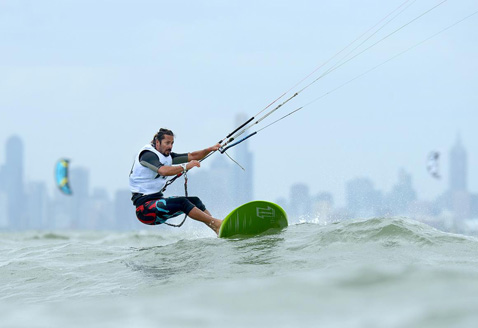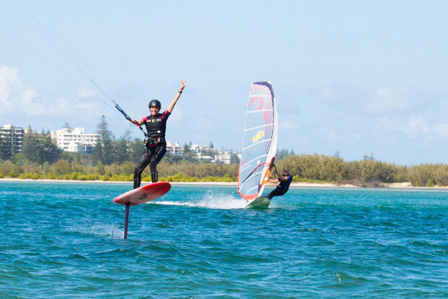
Flying high at the ISAF Sailing World Cup - Melbourne
All the big Australian names in the Olympic sailing sphere are heading to Melbourne next month for the ISAF Sailing World Cup – Melbourne, the leading internationally graded sailing event for Olympic classes in the southern hemisphere.
Seven Australian Sailing Team and Squad crews are currently competing in five of the Olympic events at Abu Dhabi at the inaugural ISAF Sailing World Cup Final. Next on the AST and Squad’s calendar is the World Cup in Melbourne, December 7-14, 2014.
The deadline of Tuesday December 2nd for entries is fast approaching and organiser Yachting Victoria is calling for final registrations.

Jeff Crow - Sport the Library
Foiling is the most significant recent development in the sport of sailing and is the centerpiece topic for the prestigious Sailing World Cup Dinner and panel discussion 'When did boats start to fly?’ on Tuesday December 9.
For the first time, the formula boards won’t be the only ones on show at this year’s ISAF Sailing World Cup – Melbourne with a new foiling exhibition event added for the kiteboarders.
Competition for the formula boards runs from Wednesday December 10 to the Medal contest on Saturday afternoon, December 13. Late that afternoon on Port Phillip the foilers will get their shot using the same short courses. Depending on numbers it “could be a bun fight” says their race officer Stephen Aulich.
On Sunday the Breakwater to Beacon endurance race for “anything that floats with a kite” has caught the attention of local kite shops and could entice an excellent field. A final three races on a short track right in front of the host club is scheduled as one of the concluding world cup events.
Ben Morrison-Jack or ‘MJ’ is both a sailor and converted foiling kiter. He reckons “A formula race board can do 17 knots upwind and high 20s downwind whereas kite foils do 19-20 knots upwind and 28-31 downwind. And that’s in 15 knots of breeze. The sport’s only been around for a couple of years; it’s going to be off the charts before you know it,” he foretells.
It’s not just less drag and therefore extra speed propelling the sport’s exploding numbers; less banging on the legs means riding foils is gentler on the body.

Queensland's Lisa Hickman, one of this year's
ISAF Sailing World Cup -
Melbourne Kiteboarding competitors
The inclusion of a kiteboarding division at the ISAF Sailing World Cup – Melbourne has generated depth and relationships among the class and the overall standard is “through the roof and the racing is tighter and faster than ever,” says ‘MJ’. International competitors are drawn by the points they earn towards their world ranking and this influx gives the local fleet a chance to check in with the best in the world.
With all ISAF Sailing World Cup events having 200 ISAF ranking points on offer, Melbourne has already attracted kiters from Germany, New Zealand, Croatia, Italy, Russia and the host nation.
So what’s the difference between formula and foiling racing?
The formula division is kiteboard racing on the standard course where windward/leeward rules apply. Four different size kites are allowed and a box rule board for the board and fin specifications are regulated. This is unique and how different shaped and size people compete against each other.
The concept of foiling kiteboards isn’t new but it’s been popularized in the market in recent years and is the sport’s future, is the collective prediction. Early models were awkward and involved ski boots and a wakeboard. Now it’s flying the same kites on the same formula courses, but instead riding a specialized hydrofoil board.
Queensland’s Lisa Hickman is one of a handful of Australian women kiters competing at the international level. She’s new to foiling and may battle it out in this exhibition event at the ISAF Sailing World Cup – Melbourne, as well as in the open formula competition where she’s taking on French champion Ariane Imbert.
“The open competition is super competitive and that lifts everyone,” says the bubbly Queenslander. “It’s a very exciting time in the sport,” Hickman agrees. “A lot of equipment has come online and it’s been hard for the racers to decide which equipment to use and specialize in.”
An average 30 kiters usually make up the division at the world cup in Melbourne. At this time of transition it’s difficult to predict final entries say those involved.
Host club Sandringham Yacht Club has embraced kite racing and made the kiters feel so welcome and very much part of the event Hickman continues, “SYC race officer Steve Aulich has travelled the world to upskill and this has made a massive difference to the professional organisation of kiting events for our community.”

Fleet action at the 2013 ISAF Sailing World Cup - Melbourne. Image: Jeff Crow - Sport the Libra
There’s a second very different paced trip south on the horizon for Hickman. Following the event she will contest the Rolex Sydney Hobart yacht race starting Boxing Day with her two older brothers, Roger and Andrew Hickman, aboard Roger’s 31 year-old yacht called Wild Rose.
The full suite of ISAF Sailing World Cup classes - 470 Men's, 470 Women's, 49er, 49FX, Finn, Laser, Laser Radial, Nacra 17, RS:X Men, RS:X Women, 2.4mR, SKUD18, Sonar, Kiteboard Men and Kiteboard Women - will be contested starting Monday December 8, 2014.
Alongside the ISAF Sailing World Cup fleets the event caters for a selection of youth and Olympic feeder classes through an extensive invited classes program including; FX (open), Laser 4.7, Laser Radial (men), Liberty, Optimist, 420, 29er, OK, Viper, 505, Minnows, Bic Techno 293 and International Cadets.
Prior to the ISAF Sailing World Cup – Melbourne is the ISAF graded Sail Sydney, December 2-7, 2014, also for invited and Olympic classes.
DOWNLOAD THE NOTICE OF RACE ENTER ONLINE
If you would like more detailed information on the event please visit the event website www.sailingworldcupmelbourne.com
TOP
|